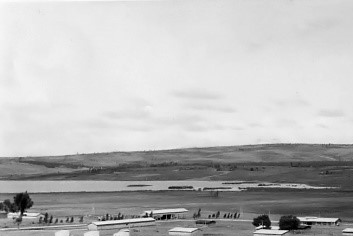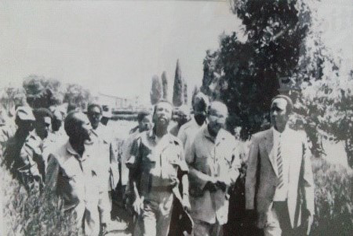Historical Background of the University
Haramaya University (HU) is one of the oldest higher learning institutions in Ethiopia which has gone through more than six decades of gigantic transformations since its establishment as an Imperial Ethiopian College of Agricultural and Mechanical of Arts (IECAMA) in the early 1950s. Its foundation was necessitated with the need for modernizing and advancing Ethiopia’s agriculture through the production of trained manpower and pragmatic research and extension programs. To this end, the governments of Ethiopia and the United States of America signed an Agreement under the Point Four Program on May 15, 1952. This was followed by the establishment of Jimma Agricultural Technical School and IECAMA. The Jimma School began to function as a source of and interim institution for the College students pending the foundation of an agricultural College. The Agreement between the Government of Ethiopia and the Technical Cooperation Administration of the Government of the United States of America was signed on May 16, 1952, which gave the mandate to Oklahoma State University (OSU) to establish and operate the College, carry out a nationwide system of Agricultural Extension via agricultural research and experimental station. Subsequently, with the recommendation of His Imperial Majesty, Emperor Haile Sellasie I, the envisioned IECAMA was established at its present location, Haramaya, near the historic Lake Haramaya. The area covers a total of 440 hectares of land. The establishment involved the construction of physical plant and enormous facilities of the campus including students’ dormitories, the cafeteria, the classrooms, the clinic, farm shop and staff dwellings largely in 1950s.


Views of the emerging campus and historic Lake Haramaya (1950s and 1960s)
With the completion of the first phase of construction in 1956, the College began its function with the arrival of its 1954 first batch of 14 students of senior class from Addis Ababa to the emerging Haramaya campus for their final semester. During its 1956/57 academic year, 11 of these students completed their studies and graduated with a B.Sc. Degree in General Agriculture.

The first graduates of the College (1957)

Emperor Haile Sellasie I, inaugurating the College (10 January 1958).
The formal inauguration of the College with the presence of the Emperor came on 10 January, 1958 with the aim of producing trained manpower in field of agriculture. This was subsequently followed by the commencement of such new B.Sc. fields of training programs in agriculture as Plant Sciences and Animal Sciences (1960), Agricultural Engineering Technology (1961), and Agricultural Economics and Business (1962). With these, the enrolment of students started to steadily increase.

Classrooms instructions by Dr.K.Keahey to One of Biology Classes students, (1958)

Cafeteria, where students were hospitably served with tasty dishes, (1950s and 1960s)
Since its inception to 1963, the College’s academic and administration wings remained virtually under the mandate and assistance of Oklahoma State University. Nevertheless, following the appointment of Mekonnen Kibret as the first Ethiopian dean of the College in 1966, the Oklahomans’ role began to be limited to the levels of supervisory and technical assistance. Following the contractual termination of Oklahoma State University in 1968, the College became a chartered member of Haile Sellasie I University (now Addis Ababa University).
Apart from agriculture, the need for trained manpower in other field of studies led to the launching of such additional academic programs in the College as Home Economics (1967), Science Teachers’ Training Program (1978) and Continuing Education Program (1980). The other milestone in the institutional history of the College of Agriculture was the launching of graduate program in the fields of Plant Sciences, Animal Sciences and Agricultural Economics in 1980.

The first female graduates in Home Economics (late 1960s)

Transformation of the College into a University of Agriculture with the historic visit of President Mengistu H/Mariam to the campus (27 May, 1985).
The College’s three decades of functions and advances in terms of teaching, research and extension programs bore remarkable value in venturing in to a new chapter of institutional development in 1985 when the Alemaya College of Agriculture upgraded its status in to a University of Agriculture. This was followed by the launching of Forestry program in 1987. The academic programs of became further diversified towards training qualified manpower in different fields of studies both at undergraduate and graduate programs.
The 1995/96 academic year ushered in another phase of institutional transformation of the University with the commencement of the Faculty of Education and Faculty of Health Sciences. These new faculties further diversified the academic programs and enabled the institution to be transformed into a full-fledged University. In the subsequent years, the University perpetuated to go through unprecedented phases of expansion and transformation in terms of physical facilities and academic programs.
New Faculties were opened which include Faculty of Law, Faculty of Business and Economics (September, 2002) Faculty of Veterinary Medicine (2003), Faculty of Technology (2004). In February 2006, Alemaya University was named as Haramaya University (HU). In 2008/09 academic years, Faculty of Applied Sciences and Faculty of Computing and Informatics were further added. The diversification of such academic units has expanded both the undergraduate and graduate programs. Going through such remarkable phases of transformations, the University then started to function in three campus premises (main campus, Harar and Chiro). Subsequently HU reorganized the previous faculties in to 10 Colleges, one Institute, and one Academy, namely: College of Agriculture and Environmental Science (CAES),College of Business and Economics(CBE) , College of Computing and Informatics (CCI), College of Medical and Health Sciences(CMHS), College of Social Sciences and Humanities(CSSH), College of Law (COL), College of Veterinary Medicine(CVM), College of Natural and Computational Sciences (CNCS), College of Education and Behavioral Sciences(CEBS) , Directorate of Continuing and Distance Education (CCDE) and Haramaya Institute of Technology (HIT) and Academy of Sport Sciences.
Under these Colleges and Institutes, the University offers diverse academic programs in both regular, and non-regular programs which include summer, Distance and Continuing Education. Besides, the University has also undertaken diverse reform activities towards restructuring itself customer responsive and offer high standard services.
Likewise, trend of research and extension programs in HU has also steadily evolved since its inception as a College. Through decades, the institution has also established linkages with the national and international organizations to strength its academic programs, research and outreach activities. As the oldest institution of agricultural education, research and extension in Ethiopia for more than six decades, the University has been developing and releasing several improved crop varieties and many crop and livestock management practices. The traditions of research and outreach programs in other emerging academic units have also been evolving, despite lack of experiences and the required manpower. In such long decades of research endeavors, the University has also produced numerous textbooks, book chapters, research articles, bulletins, proceedings, posters and PhD dissertations and master thesis research reports. The University is expected to further reorient and link its academic programs to its research and outreach activities towards making its training programs more pertinent to the needs of stakeholders and the society at large. This necessitates the need to make proper linkage with diverse stockholders. In general, in terms of research, the University is also striving to be one of the leading research Universities in Africa in 2030.
Currently, HU functions in two campus premises: the historic and main campus at Haramaya which is situated in East Hararghe Zone, close to Haramaya town, at about 510km East of Addis Ababa between Dire Dawa and Harar cities. The other campus which is exclusively devoted to the College of Health and Medical Sciences with Hiwot Fana Specialized University Teaching Hospital, is located in Harar city. In its both regular and non-regular programs, HU offers a total of 211 Regular academic programs, of which 74 are undergraduate programs, 132 postgraduate programs (104 second degree and 28 third degree program) and 4 are specialty certificates in Medicine and 6 are special certificates of Postgraduate Diploma. In these academic units, the University has now a total of 25,666 enrolled students; including 24,157 are undergraduate students, 1119 are postgraduate students, and 390 postgraduate diploma students. Besides, the University has 1381 academic and 5,553 administrative staff members.
